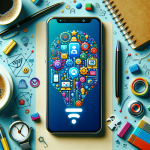
Exploring Secondary Displays on Phones: A New Frontier
Exploring Secondary Displays on Phones: A New Frontier
The world of smartphones is constantly evolving, with manufacturers pushing the boundaries of design and functionality. One of the most exciting innovations in recent years is the introduction of secondary displays on phones. This tutorial explores the concept of secondary displays, the technology behind them, and some of the latest smartphones that showcase this feature.
Table of Contents
- What is a Secondary Display?
- Benefits of Secondary Displays
- Popular Models with Secondary Displays
- How to Effectively Use a Secondary Display
- Troubleshooting Common Issues
- Summary Checklist
What is a Secondary Display?
A secondary display on a smartphone refers to an additional screen that serves various functions beyond the primary display. These can be located on the back, sides, or even as foldable extensions of the main screen. They enable users to multitask and enhance their experience by providing quick access to apps and notifications.
Benefits of Secondary Displays
- Enhanced Multitasking: Users can interact with multiple applications simultaneously, improving productivity.
- Quick Access: Secondary displays can show notifications, music controls, and other essential information without needing to unlock the phone.
- Unique Functionalities: Some models allow for different functionalities on each display, such as gaming controls on one screen while displaying gameplay on the other.
Popular Models with Secondary Displays
As of 2023, several smartphones have embraced the secondary display technology:
- LG V series: LG’s V series phones have featured a “Second Screen” that allows various functionalities like quick access to apps and customizable notifications.
- Xiaomi Mi Mix Alpha: This concept phone features a wraparound display that extends to the back, providing an immersive experience.
- ASUS ROG Phone: Known for gaming, this phone includes a secondary display module for game controls.
How to Effectively Use a Secondary Display
Step 1: Setting Up Your Secondary Display
To begin using your phone’s secondary display, check the user manual specific to your model for setup instructions. Many phones will have settings under Display in the main menu to enable the second screen.
Step 2: Customizing Display Settings
After setting up, customize how the secondary display functions. You may be able to choose from options such as:
- Which notifications appear on the secondary screen
- Quick app launches
- Customization of display brightness and color
Step 3: Experimenting with Features
Use the secondary display for various tasks. Experiment with:
- Multi-tasking by having your calendar open on one screen while browsing the web on the primary display.
- Playing games using dedicated game controls on one display while maintaining gameplay visibility on another.
Troubleshooting Common Issues
Problem 1: Secondary Screen Not Displaying
If the secondary screen is not functioning, ensure that it is enabled in the display settings. Restarting the phone can also resolve many minor issues.
Problem 2: Apps Not Responding
If applications are freezing, make sure your phone is updated with the latest software. Removing unnecessary apps running in the background can also help improve performance.
Summary Checklist
- Understand your phone’s secondary display capabilities.
- Setup and customize your secondary display settings.
- Experiment with multitasking features.
- Troubleshoot any issues as they arise.
In conclusion, secondary displays on smartphones represent a significant advancement in mobile technology, providing an innovative way to enhance user experience through expanded functionalities. As this trend grows, we can expect to see even more creative applications of secondary screens in future devices. For more about tech innovations, check out our article on Top 5 AI Tools for Business Forecasting.














